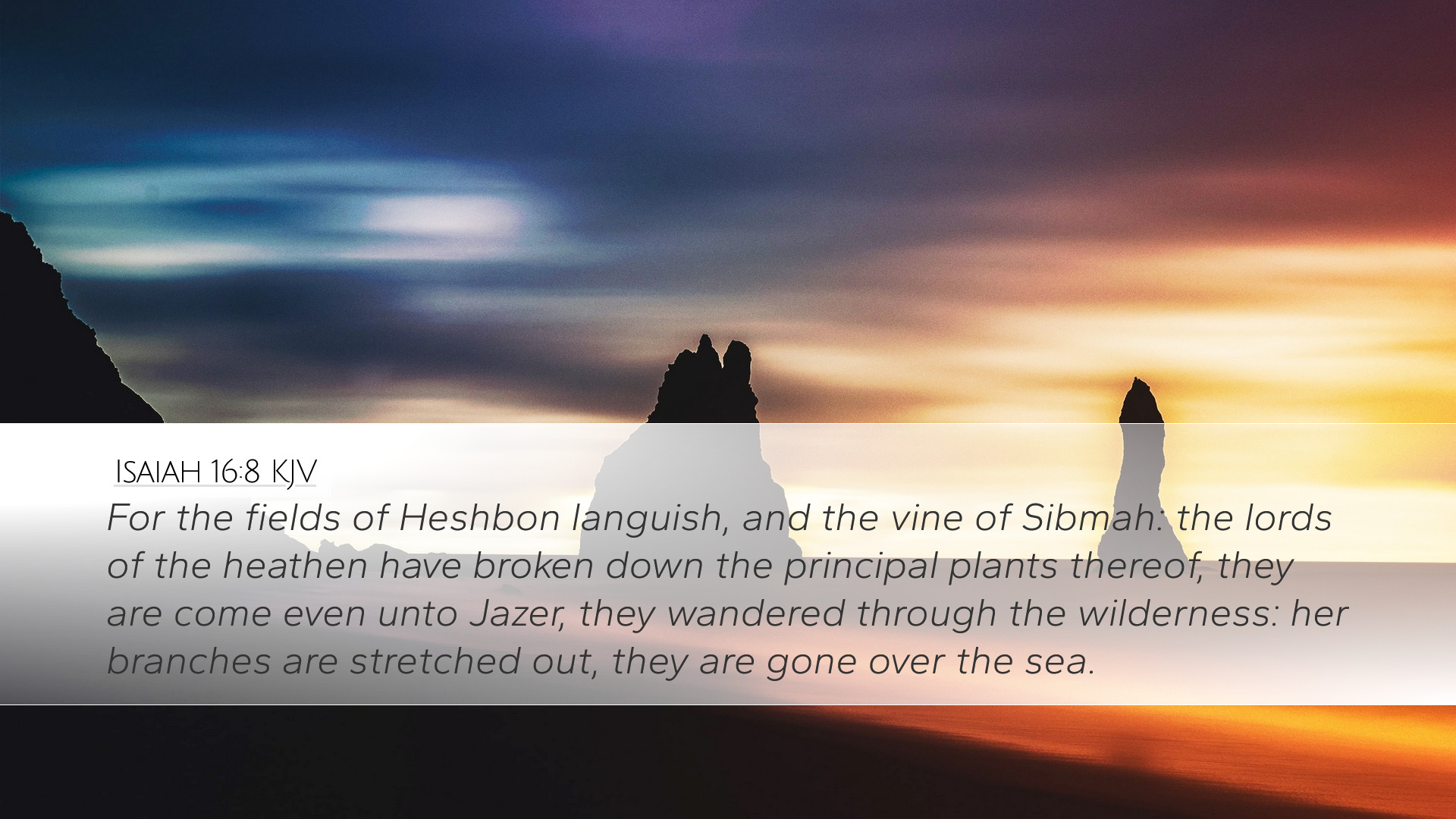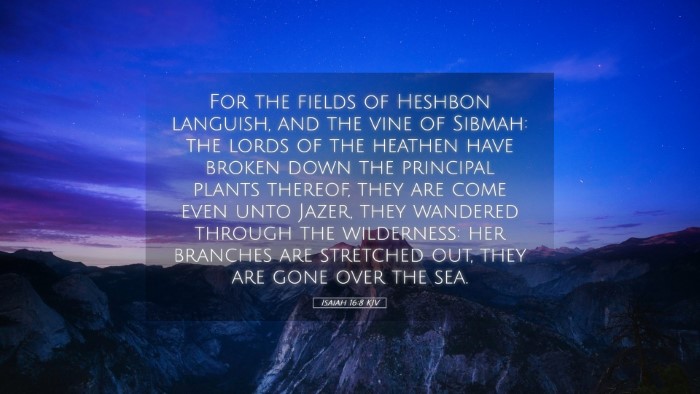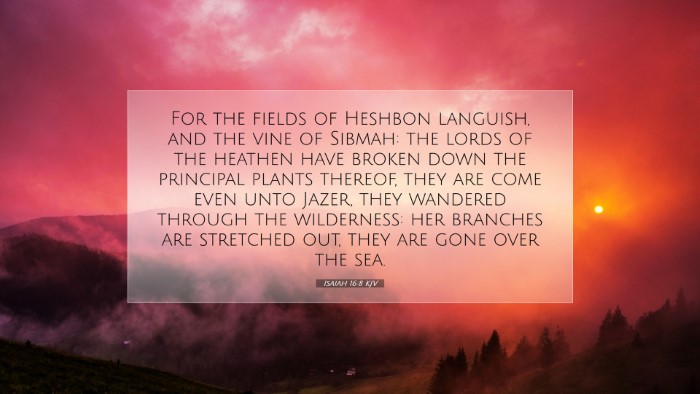Commentary on Isaiah 16:8
Text of Isaiah 16:8 (ESV): "For the fields of Heshbon languish, and the vine of Sibmah; the rulers of the nations have struck down its branches, which reached to Jazer and wandered to the desert; its shoots spread abroad and passed over the sea."
Introduction
Isaiah 16:8 illustrates the devastation that has come upon Moab and serves as a poignant reminder of the consequences of disobedience and moral decline. This commentary seeks to unravel the profound implications embedded within this verse, drawing from insights provided by notable public domain commentators.
Contextual Background
The Book of Isaiah is set against the backdrop of Assyrian dominance during the 8th century BCE. The prophet Isaiah addresses various nations, including Moab, focusing on their spiritual and moral failures. Moab, a neighboring nation, often represents rebellion against God and the ensuing judgment that follows. Understanding the historical context is essential for grasping the depth of this verse.
Verse Analysis
“For the fields of Heshbon languish”
Matthew Henry remarks that the fields of Heshbon, a significant city in Moab, were known for their agricultural productivity. The term "languish" signifies a state of decline or deterioration. This decline reflects not only a physical barrenness but also a spiritual desolation. As Heshbon's fields suffer, so too does the soul that turns away from God.
“and the vine of Sibmah”
Albert Barnes elucidates Sibmah as a place known for its lush vineyards. The imagery of the vine is rich in the Bible, often symbolizing prosperity and divine blessing. The destruction of Sibmah’s vine indicates a loss of joy and abundance, showing that when nations stray from their divine purpose, their blessings are stripped away.
“the rulers of the nations have struck down its branches”
Adam Clarke points out that the "rulers of the nations" refers to the foreign powers that exert dominion over Moab. The act of striking down the branches symbolizes a broader theme of oppression and conquest that comes upon those who turn from God. This serves as a cautionary tale for nations today; leadership grounded in righteousness is crucial to national stability and well-being.
“which reached to Jazer and wandered to the desert”
Jazer, another location in Moab, indicates the geographic boundaries of the calamity. The wandering "to the desert" emphasizes abandonment and dryness, metaphorically correlating with the spiritual condition of the people. Clarke highlights the idea that spiritual fruitfulness comes from adherence to God’s statutes, while rebellion leads to desolation.
“its shoots spread abroad and passed over the sea”
Henry interprets the reference to shoots spreading abroad as an initial indication of growth and potential. However, when these shoots are cut off and sent into desolation, it reflects the ultimate fate of any nation that forsakes God. True prosperity cannot be sustained when one's allegiance is diverted from the Creator.
Theological Implications
The destruction depicted in Isaiah 16:8 offers several theological insights:
- Divine Judgment: God’s judgment does not merely fall upon individuals but extends to nations that neglect His ways. Moab's fate serves as a solemn warning.
- Spiritual Barrenness: The decline of Heshbon and Sibmah is symbolic of the spiritual barrenness that results from turning away from God. This theme resonates throughout Scripture, emphasizing the necessity of faithfulness.
- Leadership's Role: The involvement of rulers suggests the significant influence of governance in a nation’s spiritual health. Leaders must be stewards of righteousness to foster prosperity.
- Hope Amid Judgment: While the verse outlines impending judgment, it also indicates the potential for restoration if the nation were to turn back to God.
Practical Applications
This verse calls individuals and nations to reflect on their spiritual state and the consequences of neglecting God’s commands. Here are some practical applications:
- Self-Examination: Believers are encouraged to assess their lives and address areas of spiritual decline, seeking restoration and renewal through repentance.
- Community Engagement: Church leaders and members should actively engage in prayer for their nations, embodying a collective responsibility to uphold righteousness.
- Righteous Leadership: Those in leadership positions should prioritize ethical governance, recognizing their influence on the moral fabric of society.
- Hope in God’s Mercy: Understanding the gravity of judgment must be balanced with the hope of restoration through God’s mercy, encouraging believers to trust in His sovereign plan.
Conclusion
Isaiah 16:8 encapsulates a profound message about the interplay between divine judgment and the state of a nation. By combining insights from Matthew Henry, Albert Barnes, and Adam Clarke, we uncover a multilayered understanding of this verse that resonates with leaders, students, and scholars alike. The vivid imagery serves as a timeless reminder of the importance of remaining faithful to God’s word and recognizing the consequences of moral decay. As we heed this message, we are called not only to introspection but also to action, ensuring that we contribute to a legacy of faithfulness that honors God.


